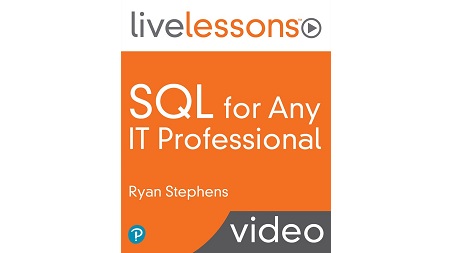
English | MP4 | AVC 1280×720 | AAC 44KHz 2ch | 83 Lessons (15h 17m) | 3.33 GB
Strong SQL skills are necessary to be competitive in the market today for IT jobs such as database administrator, programmer, application developer, database designer, and many others. SQL is the gold standard for all leading products today, including Oracle, SQL Server, and MySQL.
SQL for Any IT Professional LiveLessons will equip you with the standard language used to communicate with todays relational databases. If you want to be effective in any job that requires work with databases to access and manipulate critical data, you need to be proficient in SQL. Databases in general and SQL specifically are often portrayed as difficult topics, but video instructor Ryan Stephens explains database principles in simple terms, showing you how to create organizational success and further your career in IT.
In this video training, Ryan Stephens teaches IT professionals and aspiring IT professionals the standard database language, SQL, or Structured Query Language. This LiveLessons takes a comprehensive approach, guiding viewers through an introduction to relational databases, database design, SQL, data management, and data mining from basics to advanced queries that produce output, results, and reports in the real world.
Topics Include:
- Unmask the Simplicity of SQL
- Get to Know Your Database
- Understand the Relational Database Design Process
- Define Entities and Relationships
- Normalize Your Database
- Define Data Structures
- Create and Manage Physical Database Objects
- Manage Data and Transactions with SQL
- Query Your Database Effectively
- Join Tables in Queries
- Employ Functions to Create More Meaningful Queries
- Summarize and Group Data in a Query
- Create Advanced Queries to Get More out of Your Data
- Create Views to Expand the Capability of Your Database
- Manage Database Users and Security
- Take Your SQL Journey to the Next Level
What You Will Learn:
Through effective slides, screencasting, and hands-on exercises, Ryan Stephens shows you how to design, build, manage, and query databases using SQL.
Learn how to:
- Design and build a relational database
- Deploy a relational database using SQL
- Manage and query data using SQL
Who Should Take This Course?
- Database professionals such as DBAs, software developers, application developers, web developers and administrators, database architects, functional users working closely with data
- Non-technical users and managers who want to learn more about how to effectively manage data and optimize the use of data in their organization
Table of Contents
Introduction
1 SQL for Any IT Professional Introduction
Lesson 01 Unmask the Simplicity of SQL
2 Learning objectives
3 Understand the Relational Database and SQL
4 Explore the SQL language
Lesson 02 Get to Know Your Database
5 Learning objectives
6 Discover your sample database
7 Get to know your data via manual exploration
8 Set up your sample database
Lesson 03 Understand the Relational Database Design Process
9 Learning objectives
10 Relate database design to SQL
11 Understand the database life cycle
12 Know your data
13 Gather requirements
14 Model your data
Lesson 04 Define Entities and Relationships
15 Learning objectives
16 Understand entities, attributes, and relationships
17 Understand referential integrity
18 Define entities
19 Define attributes
20 Define relationships
21 Employ referential integrity by identifying primary and foreign keys
22 Create an entity relationship diagram
Lesson 05 Normalize Your Database
23 Learning objectives
24 Understand normalization
25 Explore the most common normal forms
26 Apply normalization to your database
Lesson 06 Define Data Structures
27 Learning objectives
28 Review your data to this point
29 Explore various datatypes in SQL
30 Fully define your data
Lesson 07 Create and Manage Physical Database Objects
31 Learning objectives
32 Review of the logical database design
33 Create and manage tables based on your design
34 Enforce database rules with constraints
35 Define other common database objects
Lesson 08 Manage Data and Transactions with SQL
36 Learning objectives
37 Populate tables with data
38 Update existing data
39 Delete data
40 Manage transactions
41 Create database objects from other objects
Lesson 09 Query Your Database Effectively
42 Learning objectives
43 Query your database without SQL
44 Explore the fundamentals of a SQL Query
45 Use operators in queries
Lesson 10 Join Tables in Queries
46 Learning objectives
47 Select data from multiple tables
48 Join tables in a query
49 Bring it together with your data
Lesson 11 Employ Functions to Create More Meaningful Queries
50 Learning objectives
51 Restructure the appearance of data character functions
52 Understand dates and times
53 Skim the surface of aggregate functions
Lesson 12 Summarize and Group Data in a Query
54 Learning objectives
55 Understand the need to group data
56 Use GROUP BY in queries
57 Place criteria on groups in queries
58 Use HAVING in queries
59 Group and summarize your data
Lesson 13 Create Advanced Queries to Get More out of Your Data
60 Learning objectives
61 Understand subqueries
62 Create subqueries to drill down further
63 Explore the concept of compound queries
64 Use compound queries to merge data sets
Lesson 14 Create Views to Expand the Capability of Your Database
65 Learning objectives
66 Understand virtual database objects
67 Create and drop views
68 Update data through a view
69 Understand performance benefits and drawbacks of views
70 Understand and define synonyms
71 Integrate views with any query
Lesson 15 Manage Database Users and Security
72 Learning objectives
73 Understand database administration versus schema management
74 Use the System Catalog as a resource
75 Manage users and privileges
76 Use roles to control access and protect your data
77 Manage a changing database
Lesson 16 Take Your SQL Journey to the Next Level
78 Learning objectives
79 Recap SQL basics
80 Explore new data integrated into our BIRDS database
81 Walk through SQL bonus examples
82 Take this bonus hands-on workshop for the road
Summary
83 SQL for Any IT Professional Summary
Resolve the captcha to access the links!